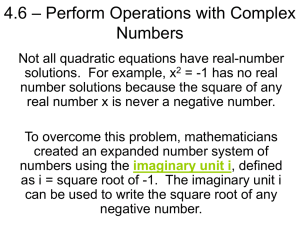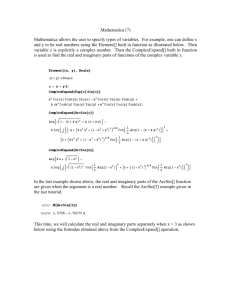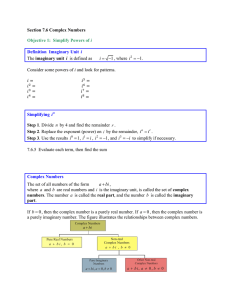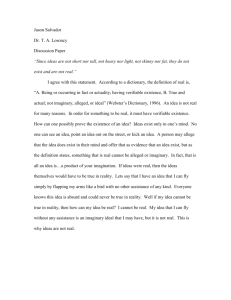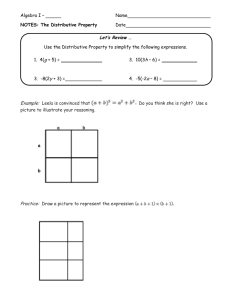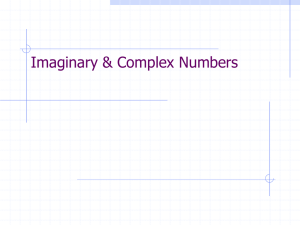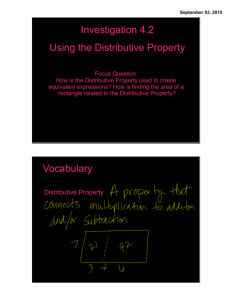The square root of a negative number
advertisement
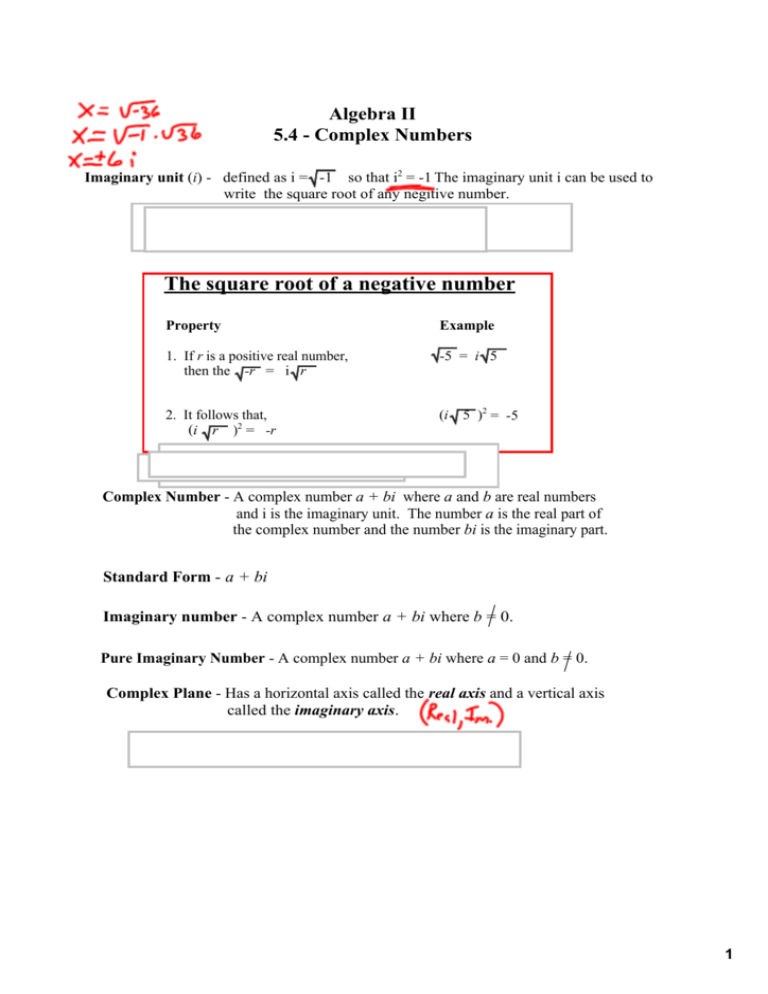
Algebra II 5.4 ­ Complex Numbers Imaginary unit (i) ­ defined as i = ­1 so that i2 = ­1 The imaginary unit i can be used to write the square root of any negitive number. The square root of a negative number Property Example 1. If r is a positive real number, then the ­r = i r ­5 = i 5 2. It follows that, (i r )2 = ­r (i 5 )2 = ­5 Complex Number ­ A complex number a + bi where a and b are real numbers and i is the imaginary unit. The number a is the real part of the complex number and the number bi is the imaginary part. Standard Form ­ a + bi Imaginary number ­ A complex number a + bi where b = 0. Pure Imaginary Number ­ A complex number a + bi where a = 0 and b = 0. Complex Plane ­ Has a horizontal axis called the real axis and a vertical axis called the imaginary axis. 1 Plot the complex numbers in the complex plane and label. imaginary a) 2 ­3i ­4 + 5i b) ­4 + 5i 3i c) 3i 4 real d) 4 2 ­3i Solve the following 1. x2 = ­16 2. 2x2 + 26 = ­10 3. x2 ­ 4 = ­ 8 4. ­2t2 ­ 8 = 46 5. 3x2 + 10 = ­26 6. x2 + 26 = ­10 Adding and Subtracting complex numbers Sum of complex numbers; (a + bi) + (c + di) = (a + c) + (b + d)i Difference of complex numbers: (a + bi) ­ (c + di) = (a ­ c) + (b ­ d)i Write the expression as a complex number in standard form. 1. (­1 + 2i) + (3 + 3i) 2. (­6 + 3i) + (5 + i) 3. (2 ­ 3i) + (3 + 7i) 4. (12 ­ 8i) ­ (­ 6 ­ 6i) 5. 2i ­ (3 + i ) + (2 ­ 3i) 6. i ­ (5 ­6i) 2 Multiplying complex numbers: When multiplying two complex numbers use the distributive property just as you do when multiplying real numbers or algebraic expressions. a) 5i (­2 + i) 5i (­2 + i) = ­10 i + 5i2 Distributive Property = ­10i + 5(­1) Use i2 = ­1 = ­5 ­ 10i Standard Form b) (7 ­4i) (­1 + 2i) (7 ­4i) (­1 + 2i) = ­7 + 14i + 4i ­8i2 Distributive Property = ­7 + 18i ­8(­1) Simplify and use i2 = ­1 = 1 + 18i Standard Form c) (6 + 3i)(6 ­ 3i) (6 + 3i)(6 ­ 3i) = 36 ­18i + 18i ­ 9i2 Distributive Property 36 ­ 9 (­1) Simplify and use i2 = ­1 45 Standard Form Complex Conjugates ­ Two complex numbers of the form (a + bi) and (a ­bi). The product of complex conjugates is always a real number. Write the following expression's as a complex number in standard form. 1. ­2i(5 + i) ___________ 2. (2 + 3i)(2 ­ 3i) 3. (7 ­ 3i)(1 ­ 4i) ___________ ________________ 4. (5 + 3i)2 _____________ 3 Write the complex conjugate for the following 3. ­8i 2. (­6 ­9i) 1. (4 + 3i) Dividing Complex Numbers The key step here is to multiply the numerator and denominator by the complex conjugate of the denominator. 5 + 3i 1 ­ 2i = 5 + 3i 1 ­ 2i 1 + 2i 1 + 2i Multiply by the conjugate of the denominator = 5 + 10 i + 3i + 6i2 = 1 + 2i ­ 2i ­4i2 Use the distributive Property ­1 + 13i = 5 Simplify ­1 13i + 5 5 Standard Form Divide the following complex numbers. 4. 7 ­ 4i 2 + i _____________ 5. 6 1 ­ i _____________ 6. 2 ­ 3i 5i ______________ Homework: Page: 277 Problems: 17­63 odd 4 Absolute Value of a Complex Number The absolute value of a complex number z = a + bi, denoted z , is a nonnegative real number defined as follows: z = a2 + b2 Geometrically, the absolute value of a complex number is the number's distance from the origin in the complex plane. Find the absolute value of each complex number. Which number is closest to the origin in the complex plane. 1. ­2 + 5i 2. ­6i 3. 5 ­ 3i Complex numbers in the Mandelbrot set To determine whether a complex number c belongs to the Mandelbrot set, consider the function x2 ­ 3x + c f(z) = z2 + c and this infinite list of complex numbers: 5



